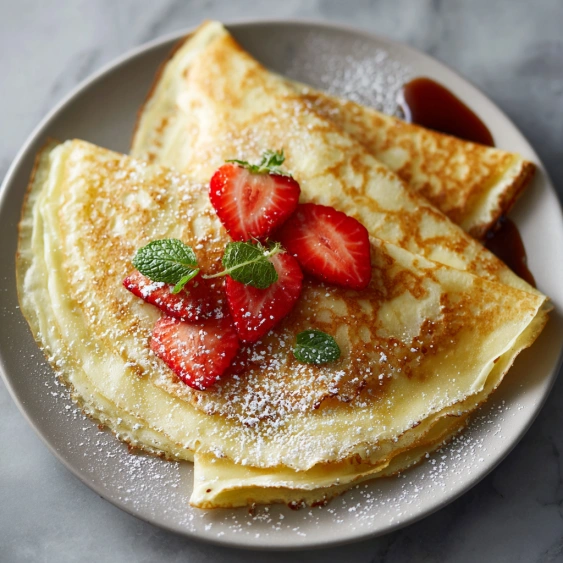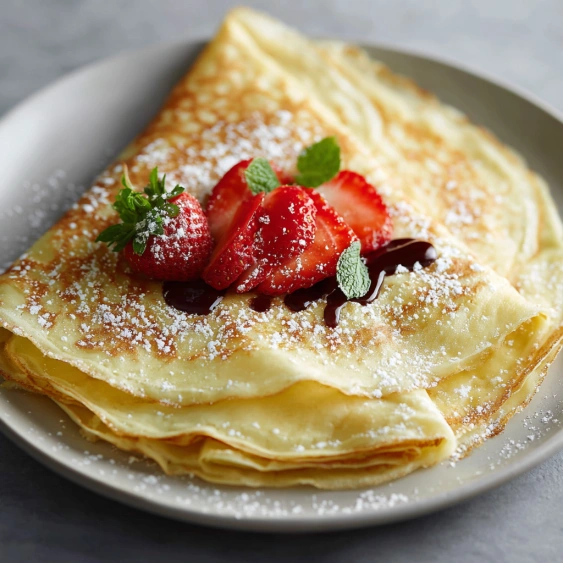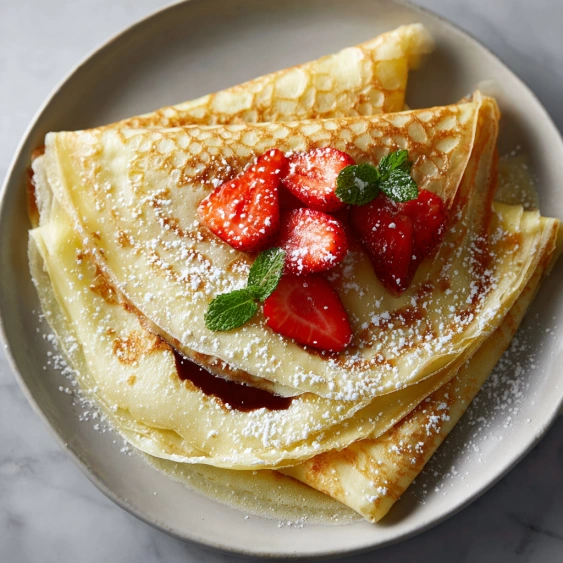 Pin it
Pin it
This easy crepe recipe transforms basic pantry ingredients into restaurant-quality, paper-thin pancakes that work equally well with sweet or savory fillings. The blender method ensures a perfectly smooth batter every time, while the quick cooking process makes this an achievable breakfast even on busy mornings.
I first made these crepes for a Mother's Day breakfast in bed surprise and have since perfected the technique. Now they're our Sunday morning tradition, with everyone choosing their own toppings.
Ingredients
- Eggs: create the structure and richness that defines a proper crepe
- Butter: adds flavor and helps create that signature golden color
- Sugar: balances the recipe, even for savory applications
- All purpose flour: provides just enough structure without becoming tough
- Milk: thins the batter to the perfect consistency
- Vanilla extract: enhances flavor for sweet versions use good quality for best results
Step-by-Step Instructions
- Blend Everything:
- Add all ingredients to your blender and process until completely smooth and no lumps remain. This takes about 30 seconds and ensures a perfectly thin batter without the arm workout of whisking by hand.
- Heat The Pan:
- Warm your nonstick skillet over medium heat until you can feel heat radiating when you hold your hand above it. Spray lightly with cooking spray for the first crepe. The pan is ready when a drop of water sizzles on contact.
- Pour And Swirl:
- Pour exactly 1/4 cup of batter into the center of the hot pan. Immediately lift and rotate the pan in a circular motion to spread the batter into a thin, even layer that covers the entire bottom of the skillet. Work quickly as the batter sets fast.
- Cook First Side:
- Watch for the edges to begin curling slightly away from the pan and the surface to look set, about 30 seconds. Peek underneath with a thin spatula to confirm a golden brown color has developed. The first crepe often serves as your test run.
- Flip Carefully:
- Slide a thin spatula completely under the crepe, lift slightly at the edge, then use your fingers or the spatula to flip it over. The second side cooks even faster, usually just 20 30 seconds until golden spots appear.
- Stack And Repeat:
- Transfer finished crepes to a plate, covering with a clean kitchen towel to retain moisture and heat. Continue cooking remaining batter, adjusting heat as needed if crepes brown too quickly or too slowly.
 Pin it
Pin it
My favorite part of this recipe is its incredible versatility. My children still remember the "crepe party" we had for my daughter's birthday where we set up a toppings bar with everything from Nutella and strawberries to ham and cheese. The memory of their excited faces as they created their own crepe masterpieces makes this recipe special beyond just its taste.
Make Ahead Options
Crepe batter can be made up to 24 hours in advance and stored covered in the refrigerator. Just whisk briefly before using as some separation may occur. This makes morning preparation virtually effortless.
Sweet Or Savory Variations
For exclusively sweet crepes add an additional tablespoon of sugar and perhaps a touch of cinnamon or lemon zest to the batter. For savory applications consider reducing sugar to 1 tablespoon and adding fresh herbs like chives or thyme plus a pinch of black pepper.
Perfect Filling Combinations
Sweet classics include fresh berries with whipped cream, Nutella with banana slices, or simply butter and a sprinkle of cinnamon sugar. For savory options try scrambled eggs with cheese and spinach, ham and gruyere, or leftover roasted vegetables with goat cheese.
Troubleshooting Tips
If your crepes tear when flipping the pan may not be hot enough or the batter might be too thin. Add a tablespoon more flour and increase heat slightly.
 Pin it
Pin it
Frequently Asked Questions
- → What's the difference between crepes and pancakes?
Crepes are much thinner than American pancakes, with no leavening agent. The batter is more liquid, allowing it to spread into a paper-thin layer when swirled in the pan. They cook faster and are typically folded or rolled around fillings rather than stacked.
- → Can I make the batter ahead of time?
Yes, crepe batter actually benefits from resting. You can make it up to 24 hours in advance and store it covered in the refrigerator. This allows the flour to fully hydrate and air bubbles to dissipate, resulting in more tender crepes.
- → Why do my crepes tear when I try to flip them?
Tearing usually happens when the crepes haven't cooked long enough on the first side. Wait until the edges curl slightly and the bottom is golden before attempting to flip. Also ensure your pan is properly heated and greased before pouring the batter.
- → What's the best pan to use for crepes?
A non-stick skillet with low sides works best, as it allows for easy flipping. While specialized crepe pans exist, any 8-10 inch non-stick pan will work well. The key is even heat distribution and a surface that allows the crepe to release easily.
- → Can I freeze leftover crepes?
Absolutely! Cool the crepes completely, then stack them with pieces of parchment paper between each one. Place in a freezer bag or airtight container and freeze for up to 2 months. Thaw in the refrigerator overnight and reheat briefly in a pan or microwave before filling.
- → How can I make these crepes savory instead of sweet?
For savory crepes, reduce the sugar to 1 tablespoon and omit the vanilla extract. You can add herbs like chopped parsley or chives to the batter. Fill with savory ingredients like ham, cheese, eggs, spinach, mushrooms or roasted vegetables.
